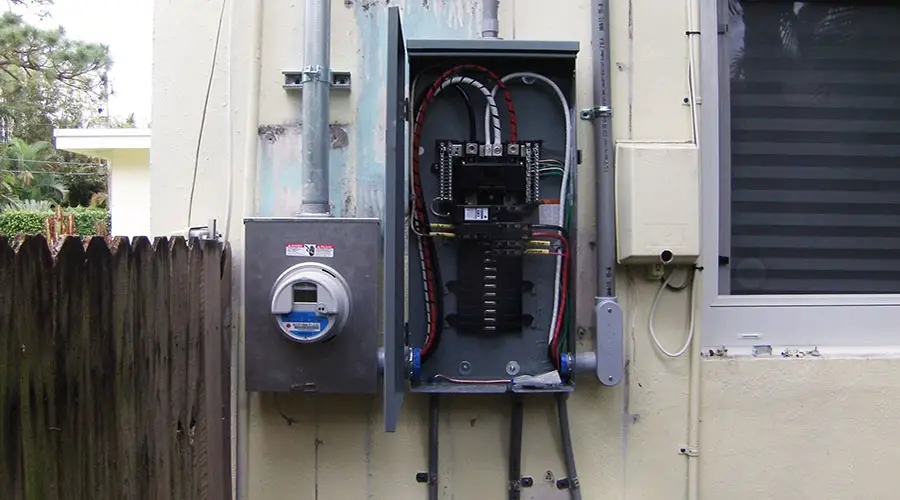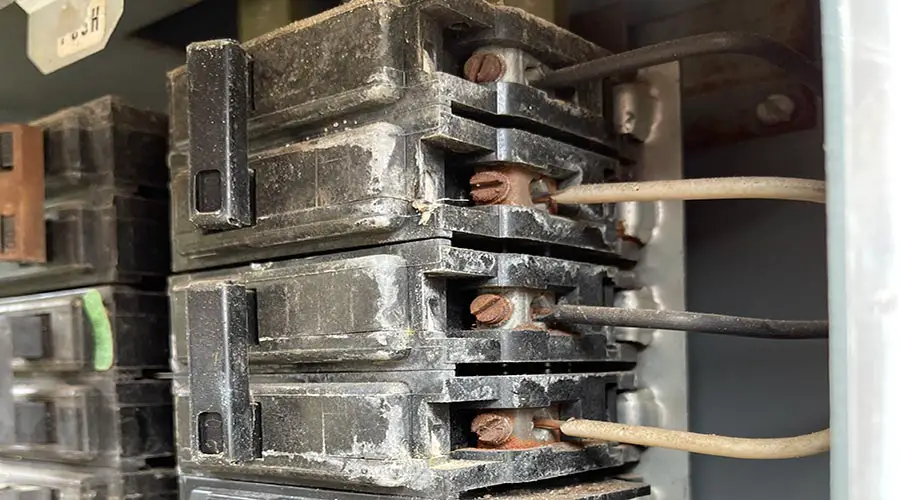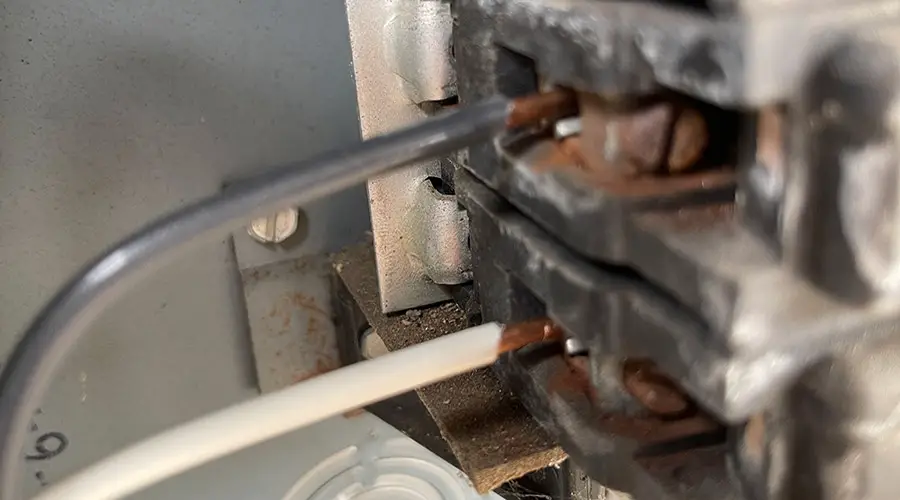Occasional water problems in a house are not uncommon in many parts of the world due to rainfall, flooding, or broken water pipes. It’s common sense that combining electricity and water is a bad idea, so naturally, most people have pressing questions when their home’s electrical panel gets wet.
Water can get into a breaker box if the housing leaks or condensation collects inside due to high humidity. Once water gets onto an electrical panel, it can cause many problems, including corrosion, fire, and breaker malfunction. If the damage is severe, you may need to replace the panel and box.
When an electrical panel gets wet, it creates a dire and potentially dangerous situation that you must resolve as quickly as possible. It’s important to know what you’re dealing with, so in this article, we’ll cover everything from what can happen if an electrical panel gets to how water gets into a breaker box.

Can a Breaker Box Get Wet?
While there are waterproof breaker boxes and electrical panels, most standard hardware is not supposed to get wet. Circuit breakers are designed for indoor use, so they are not prepared to handle water without a water-tight cover.
If you notice that your electrical panel or breaker box has water in it, the first thing to do is take a step back and don’t do anything impulsive. A wet circuit breaker can be extremely dangerous, so it is always best to call in an expert electrician to handle the situation safely. Never touch any hot electrical equipment that is wet.
Stop any water sources coming into the breaker box and dry out the entire area. Ensure the whole breaker box and circuit panel is completely dry before attempting any repairs. Also, be sure not to stand in any water while working with hot electrical components. Electrical panels should never get wet, but it’s essential to handle the situation with care and caution if they do.

5 Things That Can Happen if a Breaker Box Gets Wet
Now that you know breaker boxes aren’t supposed to come into contact with water, you’re probably wondering what can happen if they do get wet. Water getting onto a circuit breaker can cause many immediate problems, but long-term exposure can also cause a whole other set of issues. If water gets inside a breaker box, it can cause:
- Electrocution
- Corrosion to the metal breaker box
- Breaker switch corrosion
- Electrical fire
- Internal circuit breaker malfunction
Below we’ll take a closer look at five possible outcomes that may occur if water gets inside a breaker box or onto a circuit panel.
1. Electrocution Risk is High
One of the most obvious things that water on a circuit panel can cause is electrocution. Most people understand that electricity and water together can cause serious problems, but most don’t know the full extent of the danger.
Electrical panels handle lots of electricity, often at very high voltages, so getting electrocuted from one is very dangerous. Water is extremely good at conducting electricity, which increases your chance of electrocution if you touch a wet circuit panel.
To avoid getting electrocuted from a wet electrical panel, simply stay away and call a competent electrician to handle the situation safely. Stay away from touching the electrical panel or coming into contact with any water in the area. Getting electrocuted from your home’s circuit breaker can be very serious, so vacate the entire area if at all possible.
2. Corroded Electrical Panel
If water gets into a breaker box, it can cause rust and corrode the metal components. Rust is common near the bottom of the box and sometimes in the corners or on little metal ridges where small amounts of water can collect.
Long-term exposure to water will cause metal electrical boxes to rust. Not only are rust spots unsightly on a breaker box, but if left untreated, the rust can break down the metal and create holes. These corrosion holes can let even more moisture into the box, creating additional damage.
It’s best to catch rust early and treat it using a natural solution or a chemical rust remover. Letting water sit in a breaker box is never a good idea, as it can cause rust, mold, and other easily avoidable problems.

3. Electrical Component Corrosion
In addition to corroding the actual breaker box, water can cause rust on the electrical components of the breakers. Water can cause damage to wire connections (both on the service lines and branch circuits) while also corrupting screw terminals and breaker switches.
Rusted breaker switches can make turning circuits on and off more difficult, if not impossible because the switches deteriorate or get stuck. Corrosion at wire connections can also lead to voltage degradation and other electrical problems.
One of the most dangerous problems with water in an electrical panel is the risk of corrosion on the screw terminals. Corrosion on the terminals increases resistance, producing heat that can ignite an electrical fire in your breaker box.
All of that to say, water in a breaker box can wreak havoc on your electrical panel if left unchecked.
4. Electrical Fire can Occur
Water is a very destructive substance in an electrical box, and in many cases, it can directly cause a house fire. Electrical fires can happen due to various circumstances, but adding water to the equation amplifies the possible devastating outcomes.
It can corrode wire connections and screw terminals, leading to increased heat and the risk of a fire breaking out. Additionally, water can cause short-circuiting and other electrical difficulties that can cause outages and potentially fires.
While the best way to prevent electrical fires from breaking out from your breaker box is to avoid water exposure altogether, the second best thing is to dry out any water as soon as you notice it. Also, make sure to fix the source of the leak so it doesn’t happen again.

5. Circuit Breaker Malfunction
Exposure to water can also cause circuit breakers to malfunction internally. While nothing may seem wrong on the outside to the naked eye, corrosion and internal workings of circuit breakers can become severely damaged by water.
Internal corrosion of a circuit breaker can lead to many problems, from making it difficult to move the breaker switch to not reliably tripping when it’s supposed to. If your circuit breaker has internal damage that causes it not to trip when it gets too hot, you often won’t know until it’s too late.
It’s best to replace any circuit breaker that has come into contact with water just to stay safe. There can be zero exterior damage to the breaker, but the internal workings can be completely damaged and can cause it to malfunction.
How Water Gets Inside a Breaker Box and How to Fix It
Now that we’ve gone over the five primary problems that can occur when water gets into a breaker box, the next logical step is to look at how water gets to your electrical panel in the first place. There are two main water entrances into a breaker box: holes in the box (either damage or a knockout) or in the form of air humidity that condensates inside the enclosure.
There are many reasons why water might even come into contact with your breaker box in the first place, including a leaking pipe above the box, water seeping into your home from the outdoors, or flooding from excessive rainfall.
If you can stop water from getting inside your breaker box, you can potentially avoid all of the damage and problems that come with it. Below we’ll go over the three main breaker box entry points for water and how to remedy each.
Damaged Electrical Box
One of the first and most obvious places that water can get into a breaker box through holes in the metal. Breaker boxes are not water-tight, but damage can make obvious holes where water can get into the enclosure and damage your electrical panel.
Various things can cause damage to an electrical box, ranging from improper installation to corrosion. It could be a hairline crack on the top along a corner or a giant gaping hole created by rust deteriorating the box’s metal.
If a damaged electrical box is a reason for water getting in, the damage is likely on the top of the unit. Holes where water enters can also be on the sides, back, or front, but rarely are holes in the bottom a problem. Most leaks or water sources that cause electrical box damage come from above, so that should be your area of focus when searching for box damage.
Once you’ve identified the damage to your electrical box (if there is any), there are many routes that you can take regarding fixing the problem. For severe rust damage or a large hole, it’s probably best to replace the entire box. Small 15 to 20 amp breaker boxes are typically less than $100, while larger ones can get a little more expensive. You can use caulk along the area for more minor repairs to seal it up.
Circuit Entry Points
Another place for water to get into a breaker box is through the wire entry points at the back of the enclosure. You often must pop out these openings before putting wires through them, which is why they’re called “knockouts.”
Even knockout openings with wires coming through can let water into the breaker box. The water simply drips down the cables and follows them into the box, where it can cause large amounts of damage, as discussed above.
To seal up unused knockout openings in the back of your breaker box that do not currently have wires coming through them, you can use knockout seals. Knockout seals are simply cork-looking pieces of material that pop into knockout holes to close them up. They are incredibly cheap, and you can typically find them at any hardware or electrical supply store.
For knockout openings with wires currently coming through, you can seal them off using some high-temperature resistant caulk. Don’t use any type of spray foam around a breaker box, as it can trap heat inside and increase the chances of a fire.
Condensation from Air Humidity
Openings in a breaker box, whether caused by damage or an intentional knockout in the back of the box, are obvious ways water can get in, but most people overlook air humidity. While this is not a problem in all parts of the world, most homes tend to be quite humid due to heating and cooling, so it’s a consideration for many people.
Condensation from humid air can accumulate in a breaker box, leading to small puddles of water in the enclosure. Like water that makes it into a breaker box from a leaky pipe, this water can corrode and damage the electrical panel.
There are two main approaches that you can take to reduce the amount of condensation in your home’s breaker box. You can seal up your breaker box or reduce the amount of humidity in the air around your breaker box. Typically, a combination of these two approaches works best.
To seal your breaker box, never use spray foam as it can trap heat and cause a fire. Instead, apply high-temperature resistant caulk around any wires coming in or out of the box, seams, and edges that could let air inside. There are small holes on the bottom to allow water to escape on many breaker boxes; do not seal these off.
You can reduce the amount of humidity in the air by getting a small dehumidifier for the room with your home’s circuit panel. Small single-room dehumidifiers are super cheap, portable, and work well for this purpose.
Final Thoughts
You should avoid having water contact your electrical panel at all costs. However, water leaks, high humidity, and excessive rainfall happen, so it’s essential to be cautious if water does make it into your breaker box.
A wet electrical panel can easily electrocute you or start a fire. Water can also cause circuit breakers to malfunction internally, corrode electrical components, and rust metal electrical boxes.
If you notice water in your electrical panel, stay away from it to avoid electrocution and call a licensed electrician to handle the situation safely. Make sure to fix the water source, if possible, to ensure it doesn’t happen again. Also, repair any electrical box damage, block knockouts, and reduce air humidity to cut down on the amount of water that can get into your breaker box.
Replace the entire breaker box if the damage is too severe, and always replace any affected breaker switches to be on the safe side.







